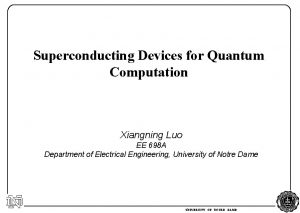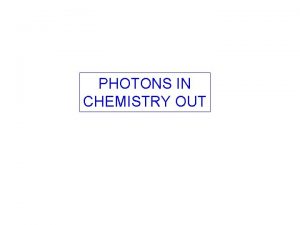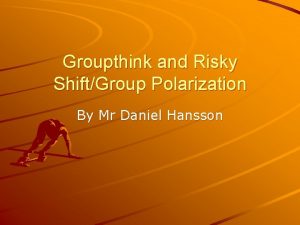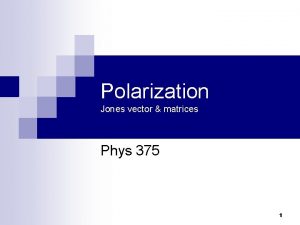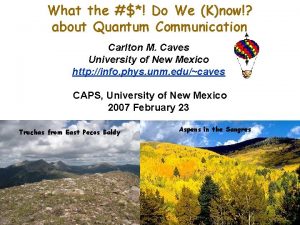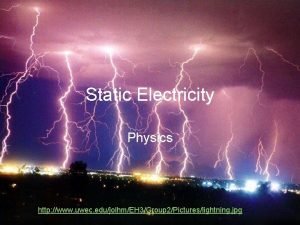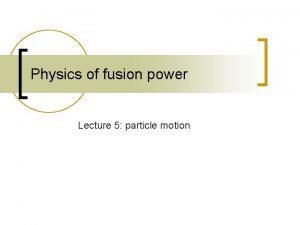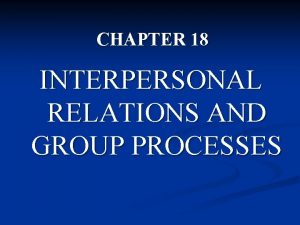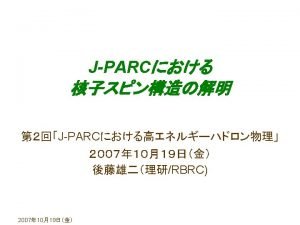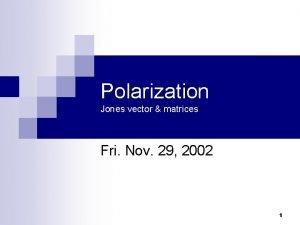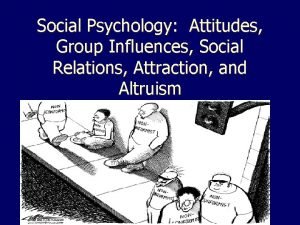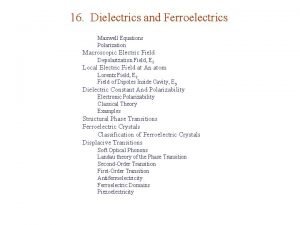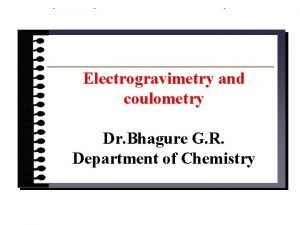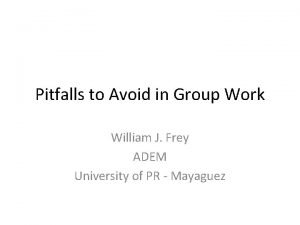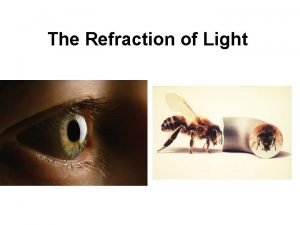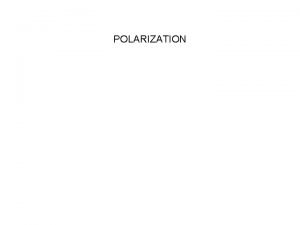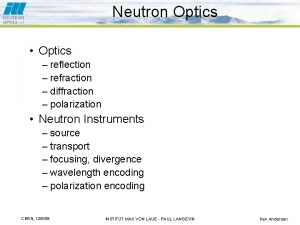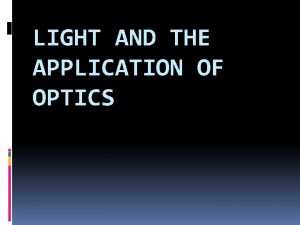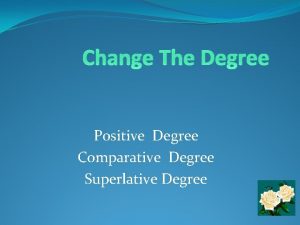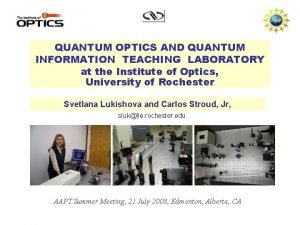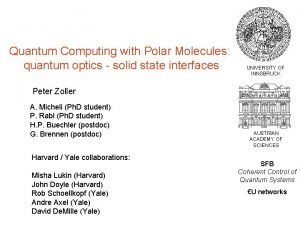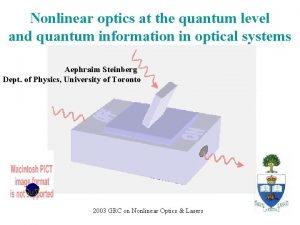UC M Degree of polarization in quantum optics























- Slides: 23

UC M Degree of polarization in quantum optics Luis L. Sánchez-Soto, E. C. Yustas Universidad Complutense. Madrid. Spain Andrei B. Klimov Universidad de Guadalajara. Jalisco. Mexico Gunnar Björk, Jonas Söderholm Royal Institute of Technology. Stockholm. Sweden. Quantum Optics II. Cozumel 2004

UC M Outline • • Classical description of polarization. Quantum description of polarization. Classical degree of polarization. Quantum assessment of the degree of polarization.

UC M Classical description of polarization • Monochromatic plane wave in a linear, homogeneous, isotropic medium E 0 is a complex vector that characterizes the state of polarization linear-polarization basis: (e. H, e. V) circular-polarization basis: (e+, e-)

UC M Stokes parameters • Operational interpretation

UC M The Poincaré sphere • Coherence vector • Poincaré sphere

UC M Transformations on the Poincaré sphere • Polarization transformations corresponding transformations in the Poincaré sphere

UC M Transformations on the Poincaré sphere • Examples A differential phase shift induces a rotation about Z A geometrical rotation of angle q/2 induces a rotation about Y of angle q

UC M Quantum fields • One goes to the quantum version by replacing classical amplitudes by bosonic operators • Stokes parameters appear as average values of Stokes operators s is the polarization (Bloch) vector The electric field vector never describes a definite ellipse!

UC M Classical degree of polarization • Classical definition of the degree of polarization • Distance from the point to the origin (fully unpolarized state)! • Problems ü It is defined solely in terms of the first moment of the Stokes operators. ü There are states with P=0 that cannot be regarded as unpolarized. ü P does not reflect the lack of perfect polarization for any quantum state. ü P=1 for SU(2) coherent states (and this includes the two-mode vacuum).

UC M A new proposal of degree of polarization A. Luis, Phys. Rev. A 66, 013806 (2002). • SU(2) coherent states associated Q function • Q function for unpolarized light

UC M A new proposal of degree of polarization A. Luis, Phys. Rev. A 66, 013806 (2002). Distance to the unpolarized state Definition • Advantages ü Invariant under polarization transformations. ü The only states with P=0 are unpolarized states. ü P depends on the all the moments of the Stokes operators. ü Measures the spread of the Q function (i. e. , localizability)

UC M Examples: SU(2) coherent states Remarks: ü =1 for all N. ü The case N=0 is the two-mode vacuum with = 0. ü In the limit of high intensity tend to be fully polarized

UC M Examples: number states Remarks: ü For classically they would be unpolarized! ü The number states tend to be polarized when their intensity increases.

UC M Examples: phase states

UC M Drawbacks • is intrinsically semiclassical. • The concept of distance is not well defined. • There is no physical prescription of unpolarized light. • States in the same excitation manifold can have quite different polarization degrees.

UC M Unpolarized light: classical vs. quantum • Classically, unpolarized light is the origin of the Poincaré sphere: • Physical requirements: ü Rotational invariance ü Left-right symmetry ü Retardation invariance The vacuum is the only pure state that is unpolarized!

UC M Alternative degrees of polarization • Idea: Distance of the density matrix to the unpolarized density matrix Hilbert-Schmidt distance • Advantages ü The quantum definition closest to the classical one. ü Invariant under polarization transformations. ü Feasible ü Related to the fidelity respect the fully unpolarized state.

UC M A new degree of polarization (I) Any state can be expressed as Main hypothesis: The depolarized state corresponding to Y is

UC M Properties of the depolarized state • The depolarized state depends on the initial state. • The depolarized state in each su(2) invariant subspace is random • The extension to entangled or mixed states is trivial.

UC M Example • States then

UC M A new degree of polarization (II) Definition: • Pure states

UC M Examples • For any pure state in the N+1 invariant subspace • Quadrature coherent states in both polarization modes

UC M Conclusions • Quantum optics entails polarization states that cannot be suitably described by the classical formalism based on the Stokes parameters. • A quantum degree of polarization can be defined as the distance between the density operator and the density operator representing unpolarized light. • Correlations and the degree of polarization can be seen as complementary.
 Difference between ray optics and wave optics
Difference between ray optics and wave optics Reflection and refraction venn diagram
Reflection and refraction venn diagram Superconducting devices in quantum optics
Superconducting devices in quantum optics Quantum physics vs quantum mechanics
Quantum physics vs quantum mechanics Quantum physics vs mechanics
Quantum physics vs mechanics Polarization in chemistry
Polarization in chemistry Group aggression
Group aggression Ap psychology social trap
Ap psychology social trap Group polarization psychology definition
Group polarization psychology definition Groupthink vs group polarization
Groupthink vs group polarization Jones matrix for half wave plate
Jones matrix for half wave plate Photon polarization
Photon polarization Charge polarization
Charge polarization Polarization drift
Polarization drift Group polarization vs groupthink
Group polarization vs groupthink Depolarization factor
Depolarization factor Jones vector elliptical polarization
Jones vector elliptical polarization Groupthink vs group polarization
Groupthink vs group polarization Ferroelectric
Ferroelectric Electrogravimetry diagram
Electrogravimetry diagram Fundamental attribution error
Fundamental attribution error Group polarization example
Group polarization example In a curved optical fiber light
In a curved optical fiber light Social inhibition
Social inhibition


